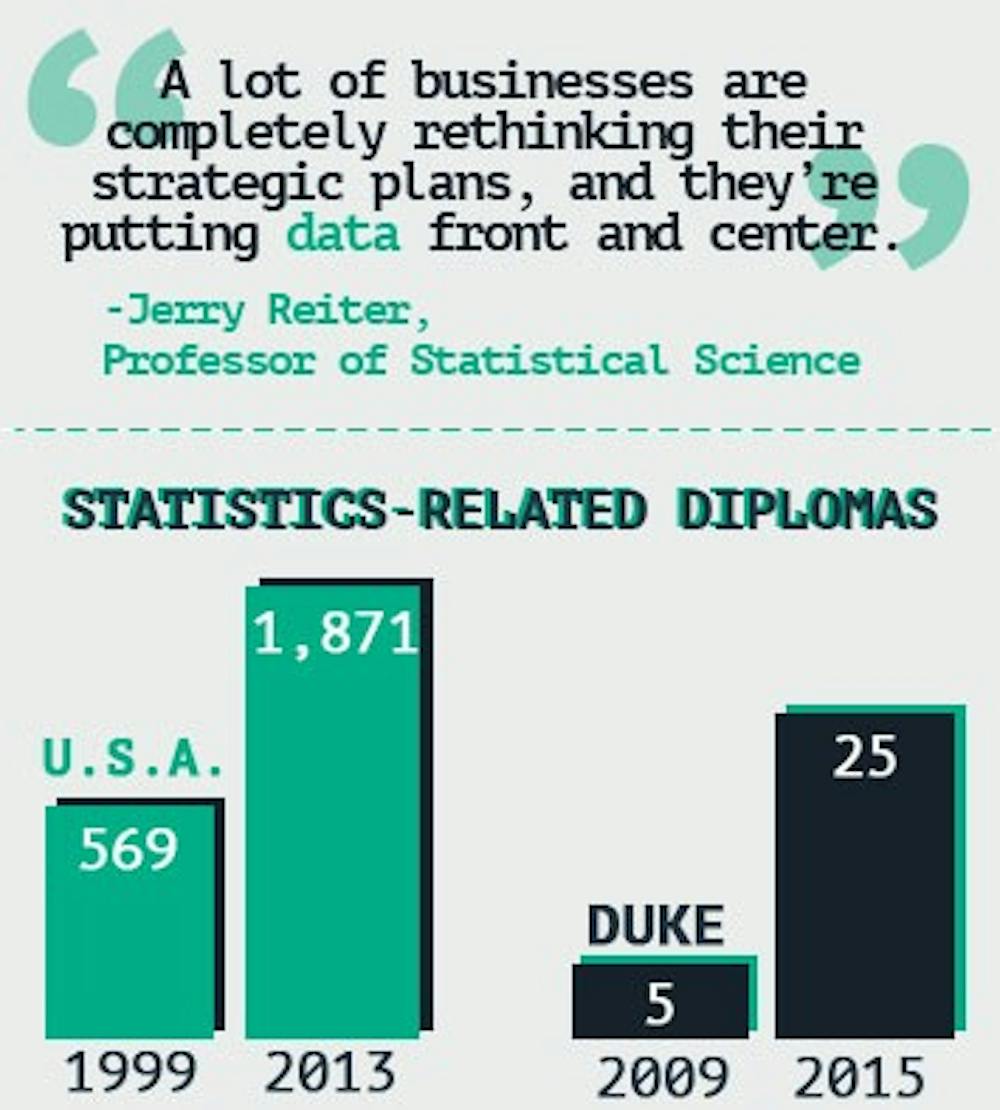Statistics departments around the country have been unable to fulfill the growing national demand for statistics skills despite a recent spike in the number of students graduating with statistics degrees.
Data released by the National Center for Education Statistics indicates that the number of statistics-related bachelor’s diplomas conferred has risen from 569 in 1999 to 1,871 in its most recent report for 2013. Master’s and doctorate degrees have increased similarly. At Duke, the Major in Statistical Science has only been awarded since 2009, but there have been similar trends as the number of undergraduate degrees has increased from 5 in its first year to 25 in the most recent class. Still, the need for a workforce educated in statistics has increased even faster.
“The potential is there for this to be a workforce crisis,” said Ronald Wasserstein, executive director of the American Statistical Association.
Newfound importance in statistics has been propelled by the rise of Big Data, an umbrella term that refers to the exponential increase in data transmitted, particularly through the omnipresence of smartphones and social media.
“What’s being needed more and more are ways to efficiently go through a lot of data as well as efficiently pull out the data that’s actually relevant,” said senior David Clancy, who will be pursuing a Ph.D. in statistics.
Utilized to its full potential, data can allow organizations in any industry to gain a competitive advantage.
“A lot of businesses are completely rethinking their strategic plans, and they’re putting data front and center,” Professor of Statistical Science Jerry Reiter said.
But while students studying technical fields such as computer science, mathematics and engineering realize the importance of statistics, students say there is a lack of awareness within the University.
“Since [statistics] is up and coming as a discipline, a lot of people just don’t understand what it is,” said statistics major Tori Hall, a senior. “It’s perceived as not being as necessary as it is.”
Sophomore statistics major Angie Shen feels that students fail to become interested in statistics because they misunderstand it to be a continuation of dry introductory courses such as AP Statistics or Statistics 101.
“I think [Statistics 101] is a representation of how statistics is perceived on campus,” Shen said. “Statistics is perceived as a method that a social scientist has to learn, but doesn’t necessarily enjoy.”
The ASA is trying to increase public awareness of the importance of statistics. Wasserstein cites the “This is Statistics” website, their national educational campaign, as one of the ASA’s most significant outreaches in recent history. Its tagline—“statistics– it’s not what you think it is”—targets its misperception by the general public.
At Duke, the statistics department has made an effort to make the major more accessible to students.
“We are designing the courses in a way so students don’t need a huge number of prerequisites before they come in,” said Mine Çetinkaya-Rundel, assistant professor of the practice and director of undergraduate studies for the statistics department.
Meanwhile, the level of interest among STEM students has outrun the limited resources of many statistics programs around the country. Duke’s program, which ranks in the top 10 nationwide according to U.S. News & World Report, has experienced a particular inability to accommodate demand, due partly to its small size compared to peers and partly to its non-traditional approaches.
The program focuses on non-traditional, Bayesian statistics and its new Master’s program is research-oriented, unlike most around the country. Reiter said that intermediate and advanced courses have had waitlists of 30 to 40 people, and just 20 applicants could be accepted into the Master’s program from a pool of 700 applicants.
“We’re in the top with fewer resources than other peer departments,” he explained. “If we had more resources, we would be able to offer more courses, more opportunities and more research.”
Students in the program endorse it heavily. Senior Katie McKenzie, who will be pursuing a MD/Ph.D. in Biostatistics, said that she loves the program, highlighting the opportunities to “apply statistics to real life situations and research.”
Wasserstein explained that if programs around the country are allowed to expand, more students will take these courses and help solve the workforce crisis.
“There’s plenty of data to suggest that if more opportunities are provided, more seats are available and students are made aware of the opportunity, then students will respond by enrolling in the programs,” Wasserstein said.
Reiter noted that it is difficult to say where the university should allocate its resources, but added that the current statistics department budget doesn’t offer any room for expansion.
“We’re not using the resources to grow, we’re using [them] to keep up with what we want to do,” he said.
Get The Chronicle straight to your inbox
Signup for our weekly newsletter. Cancel at any time.

